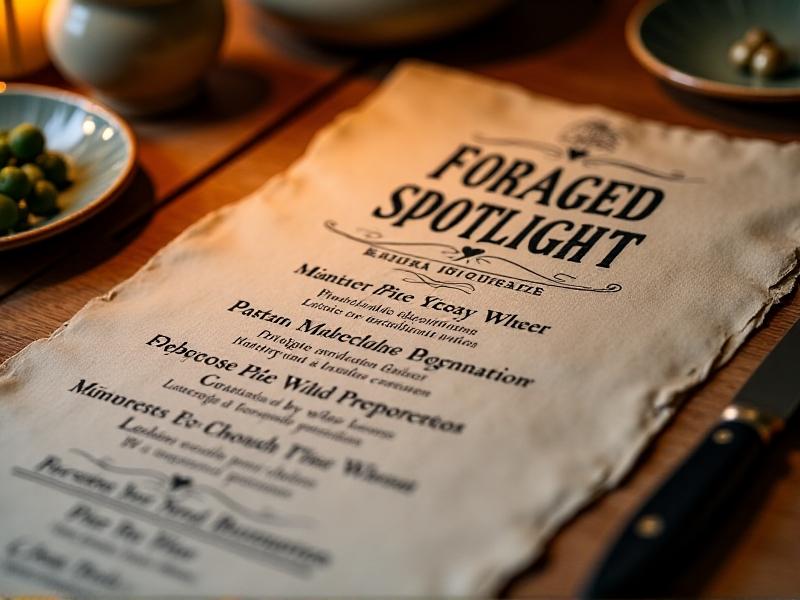Building Brand Identity Through Seasonal Foraged Menu Offerings
The Art of Foraging: A Gateway to Unique Brand Identity
Foraging, the ancient practice of gathering wild food, has seen a resurgence in the culinary world. It’s not just about sustainability or nostalgia; it’s about creating a unique brand identity that stands out in a crowded market. By incorporating seasonal foraged ingredients into your menu, you can craft a narrative that resonates deeply with your audience. This approach not only highlights your commitment to local ecosystems but also showcases your creativity and authenticity.

Seasonality as a Storytelling Tool
Seasonality is more than a trend; it’s a storytelling tool that can elevate your brand. By aligning your menu with the natural rhythms of the seasons, you create a dynamic and ever-changing experience for your customers. Foraged ingredients like ramps in spring, elderflowers in summer, wild mushrooms in autumn, and juniper berries in winter can become the stars of your dishes. This not only ensures freshness but also builds anticipation and excitement around your offerings.

Building Trust Through Transparency
Transparency is key to building trust with your customers. By sharing the story behind your foraged ingredients—where they come from, who gathers them, and how they’re prepared—you create a deeper connection with your audience. Consider including a “Foraged Spotlight” section on your menu or website, detailing the journey of each ingredient. This not only educates your customers but also reinforces your brand’s commitment to ethical and sustainable practices.

Collaborating with Local Foragers
Collaboration with local foragers can add another layer of authenticity to your brand. These partnerships not only ensure a steady supply of high-quality ingredients but also strengthen your ties to the community. Highlighting these relationships in your marketing materials can further enhance your brand’s identity as one that values local expertise and fosters meaningful connections.
Designing a Foraged Menu: Balancing Creativity and Accessibility
Designing a foraged menu requires a delicate balance between creativity and accessibility. While wild ingredients can be exotic and intriguing, they should also be approachable for your customers. Consider offering familiar dishes with a foraged twist, like a wild mushroom risotto or an elderflower-infused dessert. This approach allows your customers to explore new flavors without feeling overwhelmed, making your menu both adventurous and inclusive.
Marketing Your Foraged Offerings: Crafting a Compelling Narrative
Marketing your foraged offerings is about crafting a compelling narrative that captures the essence of your brand. Use social media, blogs, and newsletters to share behind-the-scenes stories, foraging tips, and seasonal recipes. Visual content, such as photos and videos of foraging expeditions, can be particularly effective in engaging your audience and building excitement around your menu.
Educating Your Customers: The Role of Workshops and Events
Educating your customers about foraging can further enhance your brand identity. Consider hosting workshops or events where participants can learn about identifying and preparing wild ingredients. These experiences not only deepen their appreciation for your menu but also position your brand as a thought leader in the culinary world. Plus, they provide an opportunity for your customers to connect with your brand on a more personal level.
Sustainability as a Core Brand Value
Incorporating foraged ingredients into your menu is a powerful way to demonstrate your commitment to sustainability. By sourcing ingredients that grow naturally and require minimal resources, you reduce your environmental footprint. Make sustainability a core part of your brand identity by sharing your efforts in reducing waste, supporting local ecosystems, and promoting biodiversity. This not only appeals to eco-conscious consumers but also sets your brand apart as a leader in sustainable dining.
Measuring Success: Feedback and Adaptation
Finally, measuring the success of your foraged menu offerings is crucial for continuous improvement. Gather feedback from your customers through surveys, social media, and direct interactions. Use this feedback to refine your menu, experiment with new ingredients, and adapt to changing tastes and trends. By staying responsive and innovative, you can ensure that your brand remains relevant and continues to thrive in the competitive culinary landscape.







